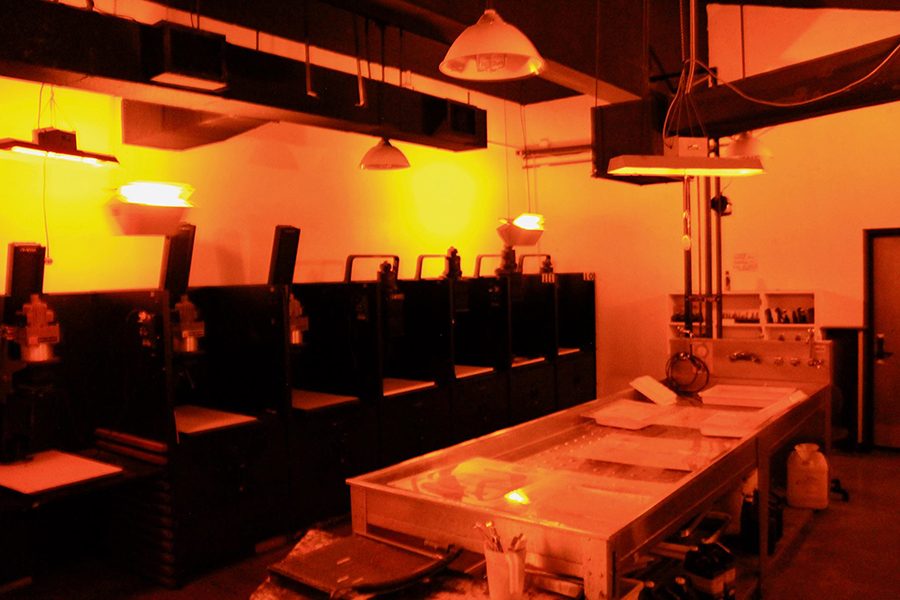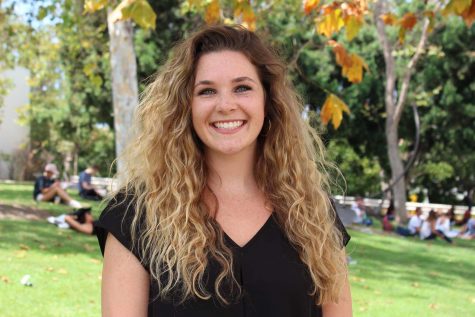Pictures nowadays can literally be taken with the touch of a finger.
Practically every individual has access to a camera and can be a photographer in their own way.
However before the age of selfies and snapchats, photography was an intense experience perfected with hours of practice and precision.
Dark room photography seems to be a thing of the past, but the art facilities at San Diego State have a darkroom changing that perception.
Tucked in a corner of the elaborate art buildings lies a photography classroom.
A small section of the walls are covered with aged blankets taped together.
A large space is scattered with racks of unrecognizable parts and equipment that seem to fit together once connected.
The sinks are littered with tubes and small photographs dangle from the ceiling.
Resting behind a revolving door, which seems to be a gate into a secret room, is a space of complete darkness.
Once safety lights are turned on, it’s clear what the room’s purpose is. The printing room, containing numerous enlargers and workspaces, is where a blank white paper turns into a tangible image.
Professor David Hewitt teaches Art 407, “Black and White Photography.”
While digital photography is the widespread practice of today, Hewitt said that darkroom techniques teach students how to use their hands.
“Students are physically making decisions using their eyes and hands and we think that’s good training for other types of art making later on,” Hewitt said.
Hewitt explained that there are two types of darkrooms.
One darkroom is a smaller, more intimate setting where individuals load the film into cameras and developing tanks. The other is a larger room where the developed negative images undergo a chemical process to then be transferred onto photo paper.
“It’s pretty magical,” Hewitt said.
Darkroom techniques were developed during the inception of photography in the early nineteenth century.
However, darkroom photography quickly decreased in popularity after the rise of color and digital markets.
Unlike digital imagery, the darkroom process allows the individual complete control over a particular photograph.
“The art world is big enough for both practices,” Hewitt said. “But there is a training that comes from the intricate and detailed process in darkrooms.”
Darkroom techniques provide the creator with a tangible photograph.
For example, Hewitt said he snaps numerous digital pictures while on vacation.
However he admits to never going back and actually viewing them.
He believes print images provide a more immediate reaction, whereas digital images can easily become lost in a camera roll.
The art world is constantly evolving. Certain practices come and go in popularity, and certain techniques naturally change.
“You know there are probably few people who have actually carved out a marble or maybe even painted with oil paint,” Hewitt said. “But everyone has a phone and everyone takes pictures so I think that has sort of democratized the act of taking pictures and being a photographer.”
Even though the accessibility to taking photographs is so widespread, Hewitt believes that photography as an art comes from the photographer’s intent.
In Art 407, students work hands on with darkroom techniques and black and white photography.
Interior design senior Melinda Lam is currently taking the course and said she didn’t realize how interesting the class would be.
“You get to learn about the process of the past,” Lam said.
In this course, Hewitt assigns students a specific theme each week.
These themes include subjects like “experimental,” “transformation” or “body.”
Students interpret these themes with their own free will and document their findings in the darkroom.
Art education senior Veronica Doa said each image developed involves a very painstaking process, but it feels more organic.
“Film captures what digital cameras can’t,” Doa said.
The processes involved in darkroom techniques allow individuals to intentionally underexpose or overexpose images.
This gives the artist creative freedom to produce a physical image from the photographs they shot.
Hewitt described darkroom photography as an anachronism, or something that belongs in another time.
Even though it is a dated practice, darkrooms continue to educate students in today’s digital world.
Many universities have taken out dark rooms and renovated the spaces for computer labs.
While there is a need for computer labs, some of these universities have re-established torn out darkrooms after realizing the importance in darkroom techniques.
Hewitt said he believes there is something to be learned from darkroom techniques that cannot be learned of digital photography.
While darkroom photography may be a thing of the past, the elements of precision, skill and technique benefit art students of all backgrounds.












